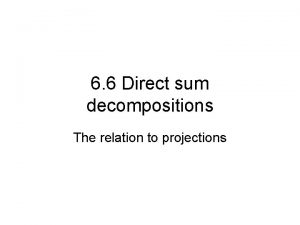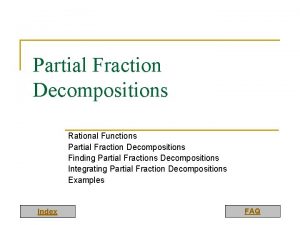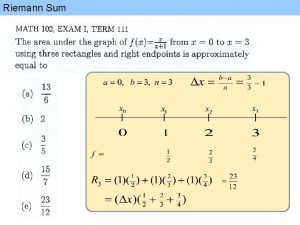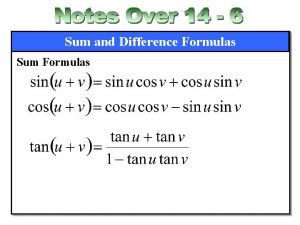6 6 Direct sum decompositions The relation to














- Slides: 14

6. 6 Direct sum decompositions The relation to projections

• W 1, …, Wk in V subspaces. W 1, …, Wk are linearly independent if a 1+…+ak=0 implies ai=0 for each i. • Lemma. TFAE: – W 1, …, Wk are independent. – – Bi basis for Wi -> B={B 1, …, Bk} is a basis for W. • Proof: omit • We write

• Example: V = Mnxn(F) – W 1 all symmetric matrices: At=A. – W 2 all antisymmetric matrices: At=-A. – Then V=W 1 W 2. • A=A 1+A 2, A 1=(A+At)/2, A 2=(A-At)/2. • Projections: E: V->V, E 2=E. E is called a projection.

• Example: E: (x, y, z)->(x, y, 0). • Properties: R=range of E. N=null E. – b in R <-> Eb=b. • (->) b=Ea, Eb=E(Ea)=Ea=b. • (<-) b=Eb. Done – I-E is a projection also: • (I-E)=I-2 E+E 2 = 1 -2 E+E=1 -E. – Im(I-E)= null E: • Let a=(I-E)b. a=b-Eb. Ea=Eb-E 2 b=Eb-Eb=0. a in null E. • a in null E. Ea=0. (I-E)a=a-Ea=a. a in Im(I-E).

– a in V. a=Ea+(a-Ea)=Ea+(I-E)a. – V=Im E Im(I-E). • Ea=(I-E)b. Ea=E 2 a=Eb-E 2 b=Eb-Eb=0. (I-E)b=0 also. – V=R N. • Im E=R. Im(I-E)=N • Projection is diagonalizable: – Let {a 1, …, ar} be a basis of R. – {ar+1, …, an} a basis for N. – B ={a 1, …, an} a basis for V which diagonalizes E. �

• Cases where there a number of projections (commuting) • Theorem 9. If V= W 1 … Wk, then there exists k linear operators E 1, …, Ek on V s. t. – – (i) Each Ei is a projection. Ei 2=Ei. (ii) Ei. Ej=0 if i j. (commuting) (iii) I=E 1+…+Ek. (iv) Range Ei = Wi. • Conversely, if E 1, . . , Ek are k linear operators satisfying (i)-(iii), then for Wi: =range Ei, V= W 1 … Wk.

• Proof: – (->) V= W 1 … Wk. • • • a=a 1+…+ak, ai in Wi. Uniquely written. Define Eja = aj. Then Ej 2=Ej. N(Ej)= W 1 … Wj-1 Wj+1 … Wk. a = E 1 a+…+Eka. I=E 1+…+Ek. Ei Ej=0 if i j. (Wj is in N(Ei)). – (<-) Let E 1, …, Ek linear operators. • a= E 1 a+…+Eka by (iii). • V= W 1+… +Wk. • The expression is unique.

• a = a 1+…+ak. ai in Wi = Im Ei. ai = Eibi. • Eja = Ej(a 1+…+ak)= Ej aj = Ej Ejbj = Ejbj= aj. • By (b) of the Lemma, W 1, …, Wk are independent. • V= W 1 … Wk • Note: A finite sum of any collection of distinct Ei is a projection. – Check:

6. 7. Invariant direct sums • V = W 1 … Wk, Wi T-invariant. – B={B 1, …, Bk} – Block form

• Theorem 10: T: V->V. V= W 1 … Wk respective E 1, …, Ek. – Each Wi is T-invariant <-> TEi=Ei. T, i=1, …, k. • Proof: (<-) Let a in Wj. a=Eja. – Ta=T(Eja)= Ej. T(a). Ta in Wj. – Wj is T-invariant. – (->) a=E 1 a+…+Eka. – Ta=T E 1 a+…+T Eka. – Since T(Eja) in Wj , T(Eja)=Ejbj for some bj.

– Ej. Ta=Ej. TE 1 a+…+Ej. TEka =Ej. T Eja =TEja. Thus, Ej. T=TEj • Theorem 11. T in L(V, V). T is diagonalizable. c 1, …, ck distinct char. Value of T. Then there exists projections E 1, …, Ek s. t. – – (i) T=c 1 E 1+…+ck. Ek (ii) I= E 1+…+Ek (iii) Ei. Ej=0 i j. (iv) Ei 2=Ei. (v) Range Ei=char. v. s. of T ass. ci. Conversely, given distinct c 1, …, ck, E 1, …, Ek with (i)(iii). Then T is diagonalizable with char. values c 1, …, ck and (iv)(v) also hold.

• Proof: (->) T diagonalizable. c 1, …, ck dist. Char. Values. – – – – – V = W 1 … Wk , Wi associated with ci. a=E 1 a+…+Eka. Ta=T E 1 a+…+T Eka=c 1 E 1 a+…+ck. Eka. T= c 1 E 1+…+ck. Ek. (<-) We need to prove (iv)(v) and T is diagonalizable. (iv) Ei. I = Ei(E 1+…+Ek)=Ei 2. T= c 1 E 1+…+ck. Ek by(i). T Ei = ci. Ei by (iii). Since Ei is not zero, ci is a char. value. T-c. I= (c 1 -c)E 1+…+(ck-c)Ek.

– If c ci for all I, then T-c. I has the null-space {0}. – T has char. values c 1, …, ck. – T is diagonalizable since char. v. s. span V. – (v) null(T-ci. I)=Im Ei. • ( ) (T-ci. I)Eia= ((c 1 -ci)E 1+…+(c i-1 -ci)E i-1+ (c i+1 -c i)E i+1+(ck-ci)Ek ) Eia = 0 by (iii). • ( ) If Ta=cia, then (c 1 -ci)E 1 a+…+(c i-1 -ci)E i-1 a+ (c i+1 -c i)E i+1 a+(ck-ci)Eka =0. • (cj-ci)Eja=0 for all j i. • a in Im Ei.

• Remark: diagonalizable operator T is uniquely determined by c 1, …, ck and E 1, …, Ek. • T= c 1 E 1+…+ck. Ek. – g(T)= g(c 1) E 1+…+g(ck)Ek – Proof omitted. • Let – Thus, Ej is a polynomial of T and hence commutes with T.
 Int sum(int a int n) int sum=0 i
Int sum(int a int n) int sum=0 i Rotem oshman
Rotem oshman Direct sum
Direct sum Vẽ hình chiếu đứng bằng cạnh của vật thể
Vẽ hình chiếu đứng bằng cạnh của vật thể Chụp tư thế worms-breton
Chụp tư thế worms-breton đại từ thay thế
đại từ thay thế Quá trình desamine hóa có thể tạo ra
Quá trình desamine hóa có thể tạo ra Sự nuôi và dạy con của hươu
Sự nuôi và dạy con của hươu Các châu lục và đại dương trên thế giới
Các châu lục và đại dương trên thế giới Dot
Dot Bổ thể
Bổ thể Nguyên nhân của sự mỏi cơ sinh 8
Nguyên nhân của sự mỏi cơ sinh 8 Phản ứng thế ankan
Phản ứng thế ankan Thiếu nhi thế giới liên hoan
Thiếu nhi thế giới liên hoan Tia chieu sa te
Tia chieu sa te



























